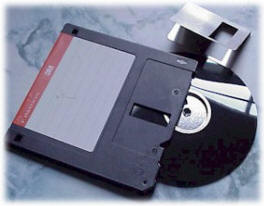| |

Return to Unit Menu | Java Main Page |
MathBits.com |
Terms
of Use
Diskettes and Hard Drives
|
 |
 |
|
3½" floppy
diskette
When you
disassemble a floppy diskette
you will see the plastic filmy surface
upon
which your data is electronically stored. |
hard disk drive
This same platter (disk) shape upon
which data is electronically stored can
also be seen in a hard disk drive. |
What happens when a
diskette is formatted?
|
 |
When
a disk is formatted (or initialized), the Disk Operating System
places tracks, sectors and bytes in a specific pattern upon the
disk.
Tracks are concentric (having the same center) circles placed upon
the disk. Sectors are subdivided sections of each track (in
red).
Bytes are further subdivisions of the sectors (in
blue).
The
number of tracks, sectors and bytes is unique to the specific
operating systems. For example, the number of tracks placed on a
disk from a Macintosh operating system is different than that of
a PC operating system. |
For instance, an IBM computer places 80 tracks, with 18 sectors per track
on a formatted disk.
|
These tracks, sectors, and bytes establish the
addresses by which a computer will store information on a disk.
Think of it like your home address. Your house is a byte. The
block upon which you live is a sector. The street upon which you
live is the track. Just as you can find your home knowing this
information, the computer can "remember" where it has placed its
information. |

Return to Unit Menu | Java Main Page |
MathBits.com |
Terms
of Use
|